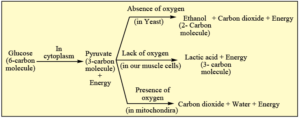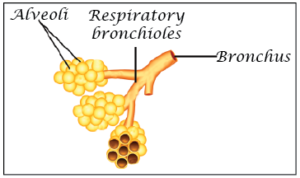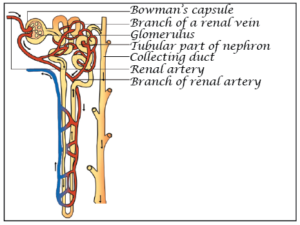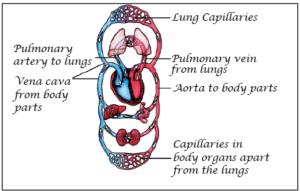Table of Contents
NCERT Solutions For Class 10 Science Chapter 6 Question Answer
NCERT solutions for Class 10 Science chapter 6 Life Processes includes all of the questions from class 10 NCERT textbook that are required by the CBSE board. We provide you with thorough NCERT solutions that have been solved by subject matter experts with accuracy. The language used is simple enough for pupils to understand, and it is written with the goal of getting the best possible results on the CBSE Class 10 Term I exams.
Class 10 Science chapter 6 Life Processes NCERT allows students to swiftly scan a full chapter at once, which is useful for last-minute studying. This chapter’s NCERT Solutions for Class 10 Science were created with a concept-based approach in mind, allowing students to respond precisely, which is the most crucial aspect to remember for the CBSE Term I exams.
NCERT Solutions for Class 10 Science Chapter 6 PDF Download
Get accurate NCERT solutions for class 10 Science chapter 6 Life Processes, which covers essential topics related to the biological processes that maintain life, such as nutrition, respiration, transportation, and excretion in living organisms. To make your preparation easy, we bring you NCERT Solutions for Class 10 Science Chapter 6 in PDF, where all important questions are solved step-by-step to help you excel in exams.
Class 10 Science Chapter 6 Life Processes Question Answers
1. Why is diffusion insufficient to meet the oxygen requirements of multicellular organisms like humans ?
A. i) In multicellular organisms, all the cells are not in direct contact with the surrounding environment.
ii) Hence, simple diffusion will not meet the oxygen requirements of all the cells of multicellular organisms like humans.
2. What criteria do we use to decide whether something is alive ?
A. The criteria (features) we use to decide something alive are :
i) movement ii) respiration
iii) nutrition iv) growth, development, etc.
3. What are outside raw materials used for by an organism ?
A. Outside raw materials are used by an organism for obtaining energy which is needed for maintenance processes to prevent damage and breakdown.
4. What processes would you consider essential for maintaining life ?
A. I consider life processes like respiration, nutrition, transportation, excretion, etc. as essential for maintaining life.
5. What are the differences between autotrophic nutrition and heterotrophic nutrition?
A.
| AUTOTROPHIC NUTRITION | HETEROTROPHIC NUTRITION |
| i) It is a mode of nutrition in which organisms prepare their own food. | i) It is a mode of nutrition in which organisms depend on others for their food. |
| ii) All green plants and some bacteria exhibit this type of nutrition. | ii) All animals and fungi exhibit this type of nutrition. |
Also read: Extra Questions for Class 10 Science Chapter 6 Life Processes
6. Where do plants get each of the raw materials required for photosynthesis ?
A. Plants get :
i) carbon dioxide from the atmosphere.
ii) water from the soil.
iii) light energy from the sun.
7. What is the role of the acid in our stomach ?
A. i) Hydrochloric acid (HCl) produced by gastric glands of stomach creates an acidic medium in the stomach which is necessary for the activation of enzyme pepsin.
ii) It also helps in killing the germs that enter along with the food.
8. What is the function of digestive enzymes ?
A. i) The food materials we consume are very complex in nature.
ii) Digestive enzymes help to breakdown these complex molecules into smaller molecules, so that they can be absorbed by the cells.
Eg : Amylase, lipase, pepsin, trypsin, etc.
9. How is the small intestine designed to absorb digested food ?
A. i) The inner lining of small intestine has a large number of finger like projections called villi.
ii) These villi provide a large surface area for absorption of digested food.
iii) The villi are richly supplied with blood vessels. These blood vessels carry the absorbed food to each and every cell of the body.
10. What advantage over an aquatic organism does a terrestrial organism has with regard to obtaining oxygen for respiration ?
A. i) Aquatic organisms obtain oxygen dissolved in water whereas terrestrial organisms take in oxygen from the air directly.
ii) The aquatic organisms have to utilize more energy to extract sufficient oxygen from water as the volume of oxygen is quite low in the water.
iii) Whereas terrestrial organisms relatively need less energy to obtain oxygen from surroundings as the amount of oxygen is very high in the atmosphere.
iv) Hence, it is an advantage for terrestrial organisms with regard to obtaining the oxygen for respiration.
11. What are the different ways in which glucose is oxidized to provide energy in various organisms?
A. i) In the first phase of respiration, glucose is broken down into two molecules of pyruvate. This is common in all kinds of organisms (in all kinds of respiration).
ii) The fate of pyruvic acid is different in different organisms.

12. How are oxygen and carbon dioxide transported in human beings ?
A. Transport of Oxygen : The oxygen of the air in lungs combines with the haemoglobin present in blood to form oxyhaemoglobin and is carried to the cells.
Transport of carbon dioxide : Carbon dioxide is more soluble in water. Hence, it is mostly transported from body tissues in the dissolved form through blood plasma to lungs.
13. How are the lungs designed in human beings to maximize the area for exchange of gases?
A. i) In the lungs, the air passage (wind pipe) divides into smaller tubes, called ‘bronchi’ which in turn divide and form ‘bronchioles’.
ii) The bronchioles terminate in balloon – like structures, called ‘alveoli’. Each lung contains 300 – 350 millions of alveoli.
iii) The alveoli present in the lungs provide maximum surface for the exchange of gases.
iv) The alveoli have very thin walls and contain an extensive network of blood vessels to facilitate exchange of gases.

14. What are the components of the transport system in human beings ? What are the functions of these components ?
A. Transport system in human beings consists of heart, blood and blood vessels.
Functions :
Heart –
i) Heart is a pumping organ to push and pull blood around the body.
ii) Heart receives the deoxygenated blood from various parts of the body. It sends this impure blood to lungs for oxygenation.
iii) After receiving pure blood from lungs, it sends this oxygenated blood throughout the body.
Blood –
i) It is a fluid connective tissue. It consists of : (a) plasma, (b) RBC, (c) WBC and (d) blood platelets.
ii) Plasma transports food, hormones, CO2 and nitrogenous wastes in dissolved form. RBC transports respiratory gases.
iii) WBCs protect the body from infections and platelets prevent the loss of blood at the time of injury by forming blood clots.
Blood vessels –
i) There is a network of blood vessels which contain arteries, veins and capillaries.
ii) They help in the circulation of blood throughout the body.
15. Why is it necessary to separate oxygenated and deoxygenated blood in mammals and birds ?
A. It is necessary to separate oxygenated and deoxygenated blood to maintain efficient supply of oxygen in the body.
NCERT Exemplar Solutions for Class 10 – Free PDF Download
16.Write a note on the components of the transport system in highly organised plants.
A. The main components of transport system in highly organised plants are Xylem and Phloem.
Xylem : a) It consists of vessels and tracheids.
b) It helps to conduct water and minerals from soil to the leaves.
Phloem : a) It consists of sieve tubes and companion cells.
b) It helps to transport food materials from leaves to various parts of the plant. This process is called translocation.
17. How are water and minerals transported in plants ?
A. i) In xylem tissue, vessels and tracheids of the roots, stems and leaves are interconnected to form a continuous system of water-conducting channels reaching all parts of the plant.
ii) At the roots, cells in contact with the soil actively take up ions.
iii) This creates a difference in the concentration of these ions between the roots and the soil.
iv) Water, therefore, moves into the root from the soil to eliminate this difference.
v) This means that there is a steady movement of water into root xylem, creating a column of water that is steadily pushed upwards.
18. How is food transported in plants ?
A. i) The products of metabolic processes, particularly photosynthesis, are moved from leaves, where they are formed, to other parts of the plant.
ii) This transport of soluble products of photosynthesis is called translocation and it occurs in the part of the vascular tissue known as phloem.
iii) Besides the products of photosynthesis, the phloem transports amino acids and other substances.
iv) These substances are especially delivered to the storage organs of roots, fruits and seeds and place in the sieve tubes with the help of adjacent companion cells both in upward and downward directions.
19. Describe the structure and functioning of nephron.
A. Structure of Nephron :
i) Nephron is the filtration (functional) unit of kidney. It consists of a tubule which is connected with collecting duct at one end and a cup-shaped structure at the other end.
ii) This cup-shaped structure is called ‘Bowman’s capsule’. Every Bowman’s capsule contains a cluster of capillaries, called ‘Glomerulus’.
iii) The blood enters into Glomerulus through afferent arteriole of renal artery and leaves it through efferent arteriole.
iv) The tubular portion consists of proximal convoluted tubule, loop of Henle, distal convoluted tubule and collecting duct.

Functions of Nephron :
i) Filtration : Filtration of blood takes place in Bowman’s capsule from the capillaries of glomerulus.
ii) Reabsorption : As the filtrate flows along the tubule, useful substances such as glucose, amino acids, salts and water are selectively reabsorbed into the blood by capillaries surrounding the nephron tubule.
iii) Urine formation : The filtrate which remains after the reabsorption is called urine. Urine contains dissolved nitrogenous wastes, i.e. urea, uric acid, excess salts and water.
20. What are the methods used by plants to get rid of excretory products ?
A. i) Some waste products are stored in the leaves. They are removed as the leaves fall off.
ii) Some waste products such as resins and gums are stored, especially in non-functional old xylem.
iii) Some waste products such as tannins, resins, gums are stored in bark, thereby removed or peeled off.
iv) Plants excrete some waste products through roots into the soil around them.
v) Plants also get rid of excess water through transpiration.
21. How is the amount of urine produced regulated ?
A. i) The reabsorption of the urine produced by Bowman’s capsule takes place in the tubular portion.
ii) When filtrate reaches the tubular portion the epithelial cells of the tubule reabsorb several substances (water and salts) in a selective manner and transport them back to blood. Thus the amount of urine produced is regulated.
iii) The amount of urine is also regulated by volume of blood that is filtered and the amount of Antidiuretic hormone (ADH).
22. How are fats digested in our body ? Where does this process takes place ?
A. i) Bile salts break the large globules of fats into smaller globules increasing the efficiency of enzyme action (emulsification).
ii) An enzyme called lipase present in the intestinal juice finally breaks down the fats into fatty acids and glycerol.
iii) This process takes place in the small intestine.
23. What is saliva ? What is the role of saliva in the digestion of food ?
A. i) Saliva is a watery fluid secreted by salivary glands.
ii) Saliva moistens the food and help in the movement of food around the mouth while chewing.
iii) Enzyme present in the saliva, salivary amylase (ptyalin) breaks down the starch into sugars.
24. What are the necessary conditions for autotrophic nutrition and what are its by-products ?
A. i) The necessary conditions for autotrophic nutrition are :
a) Presence of chlorophyll
b) Provision of water
c) Availability of sufficient sunlight to provide the energy
d) Sufficient supply of carbon dioxide
ii) The by-products of autotrophic nutrition are carbohydrates, oxygen and water.
25. What are the differences between aerobic and anaerobic respiration? Name some organisms that use the anaerobic mode of respiration.
A.
| AEROBIC RESPIRATION | ANAEROBIC RESPIRATION |
| i) Aerobic respiration takes place in the presence of oxygen. | i) Anaerobic respiration takes place in the absence of oxygen. |
| ii) In this, glucose is completely oxidised. | ii) In this, the glucose molecule is incompletely broken down. |
| iii) Large amount of energy (686 K.Cal.) is released, i.e. 36 ATP molecules per glucose molecule.. | iii) Small amount of energy (56 K. Cal.) is released, i.e., 2 ATP molecules per glucose molecule. |
| iv) It takes place in all higher organisms. | iv) It takes place in lower organisms like Yeast and muscle cells of man, etc. |
The organisms which perform anaerobic mode of respiration are Yeasts, bacteria and parasites like tapeworm, Ascaris, etc.
26. How are the alveoli designed to maximise the exchange of gases ?
A. i) Alveoli are thin walled balloon like structures present in lungs.
ii) The balloon like structure of alveoli increase their surface area.
iii) The walls of alveoli are richly supplied with a network of blood vessels which helps to maximise the exchange of gases.
27. What would be the consequences of deficiency of haemoglobin in our bodies ?
A. i) If haemoglobin is deficient in the blood, its oxygen carrying capacity decreases.
ii) It results in the deficiency of oxygen in our body cells.
iii) This condition leads to breathlessness and anaemia.
28. Describe double circulation in human beings. Why is it necessary ?
A. i) In human beings, the blood passes through the heart twice in a circulation and is called double circuit heart.
ii) This kind of circulation in which blood circulates twice through the heart is called double circulation.
The double circulation of blood includes :
i) Systemic Circulation ii) Pulmonary Circulation
Systemic circulation :
i) In this circulation, oxygenated blood from the left atrium is pumped into the left ventricle.
ii) From the left ventricle, blood is pumped into the systemic aorta.
iii) This aorta supplies blood to various organs in the body.
iv) The deoxygenated blood from the various organs is collected by inferior and superior vena cavae and finally into the right atrium.
Pulmonary circulation :
i) In this circulation, deoxygenated blood from the right atrium is sent into right ventricle.
ii) From right ventricle, blood is pumped to the lungs
iii) In the lungs, the blood is oxygenated and the oxygenated blood is returned to the left atrium by pulmonary veins.
iv) From the left atrium, the oxygenated blood is again transported to various body parts through aorta.

Necessity (importance) of double Circulation :
i) Double circulation is useful to prevent mixing of deoxygenated blood with oxygenated blood.
ii) This ensures the high and efficient supply of oxygen to the cells of the body.
29.What are the differences between the transport of materials in xylem and phloem?
A.
| XYLEM | PHLOEM |
| i) Xylem conducts water and dissolved minerals from roots to leaves and other parts. | i) Phloem conducts prepared food material from leaves to other parts of plant in dissolved form. |
| ii) In xylem, transport of materials takes place through vessels and tracheids which are dead tissues. | ii) In phloem, transport of materials takes place in the sieve tubes with the help of companion cells, which are living cells. |
| iii) In xylem, upward movement of water and dissolved materials is mainly achieved by transpiration pull. | iii) In phloem, translocation of food and other substances takes place both in upward and downward directions. |
| iv) Movement of water is achieved by simple physical forces. There is no expenditure of energy. So, ATP molecules are not required. | iv) The translocation in phloem is an active process and requires energy. This energy is taken from ATP. |
30. Compare the functioning of alveoli in the lungs and nephrons in the kidneys with respect to their structure and functioning.
A.
| ALVEOLI | NEPHRON |
| i) Alveoli are the structural and functional units of lungs (respiratory system). | i) Nephrons are the structural and functional units of kidneys (excretory system). |
| ii) Alveolus has thin walled balloon-like structure. Surface is fine and delicate. | ii) Nephron has thin walled cup-shaped structure attached with thin walled tubule |
| iii) Alveoli are supplied with extensive network of thin walled blood vessels. (i.e. capillaries for exchange of gases). | iii) Bowman’s capsule is supplied with a cluster of capillaries called glomerulus for filtration. A network of blood vessels is present around the tubular part of nephron for reabsorption of useful substances and water. |
| iv) Alveoli increase surface area for diffusion of O2 from air to blood and CO2 from blood to air. | iv) Nephrons also increase surface area for filtration of blood and reabsorption of useful substances and water from filtrate leaving behind urine. |
NCERT Solutions for Class 10 Science Chapter 6 Question Answer All Chapters
Chapter 6 – Life Processes NCERT Solutions for 10th Class Science
We learn about numerous variables that contribute to a being’s ability to live in Chapter 6 of NCERT Solutions for Class 10 Science. The different processes that are required to maintain and support life, such as respiration, nourishment, material transportation, and excretion of digested food, are briefly discussed in this chapter. The many forms of nutrition, such as autotrophic and heterotrophic nutrition, are addressed in depth. A basic overview of the human digestion process is provided, including food ingestion, food passage through the alimentary canal, food absorption, and the point at which digested food is ready for excretion.
Students learn about the process of respiration (which can be aerobic or anaerobic) from inhalation to the breakdown of organic compounds thanks to the supply of energy in the form of ATP in this chapter. The circulatory system, which is explained, is responsible for transporting substances such as food, carbon dioxide, oxygen, and other materials in people. Blood, blood arteries, and the heart are among the circulatory system’s constituents that are briefly discussed. In this chapter, the various functions of the excretory organs, as well as their structure, are discussed in general. Excretion in plants and the strategies plants utilize to excrete waste products are also covered in the NCERT Solutions for Class 10 Science Chapter 6.
Also Check
- NCERT Solutions for Class 10 Maths
- NCERT Solutions for Class 10 Science
- NCERT Solutions for Class 10 Social Science
- NCERT Solutions for Class 10 English
NCERT Solutions for Class 10 Science Chapter 6 Life Processes: Key Features
- NCERT Solutions make it easier for pupils to study for the CBSE Class 10 Term I examination.
- This chapter provides students with a step-by-step explanation to help them better understand subjects.
- Wherever possible, diagrams are included to aid visual learning.
- As is customary in CBSE Term I exams, the solutions are brief and to the point.
- Chapter 6 solutions have been solved using the CBSE blueprint and the NCERT textbook.
FAQs on Class 10 Science Chapter 6 Question Answer Life Processes
What are life processes class 10 NCERT solutions?
Chapter 6 of Class 10 Science is titled Life Processes. It deals with the biological activities essential for the survival of organisms. The chapter covers key processes like nutrition, respiration, transportation, and excretion in both plants and animals. It explains how organisms consume and utilize energy, transport essential substances, and eliminate waste products. This chapter lays the foundation for understanding human physiology and plant functions, making it crucial for board exams and future studies in biology.
Which life process is eating food?
Eating food is a part of the life process called nutrition. In this process, organisms obtain and consume food, which provides the energy and raw materials required for growth and maintenance. For humans, nutrition involves both ingestion (eating) and digestion, where food is broken down into simpler molecules that the body can absorb. In plants, nutrition occurs through photosynthesis, where they make their own food using sunlight, water, and carbon dioxide.
What is life class 10?
In Class 10 Science, life is defined as the ability of an organism to perform biological functions necessary for survival and reproduction. These functions include nutrition, respiration, transportation, excretion, reproduction, and growth. Life is marked by processes that help organisms adapt to their environment, sustain energy needs, and ensure the continuation of their species through reproduction. The study of life processes in this chapter helps students understand the basic physiological activities common to all living beings.
What transports oxygen in the blood?
The transport of oxygen in the blood is carried out by a protein called hemoglobin found in red blood cells (RBCs). Hemoglobin binds to oxygen molecules in the lungs and carries them through the bloodstream to different tissues and organs in the body. Once oxygen reaches the cells, it is used for cellular respiration, generating energy. At the same time, hemoglobin also collects carbon dioxide from the cells and transports it back to the lungs for exhalation, maintaining a balance of gases in the body.










